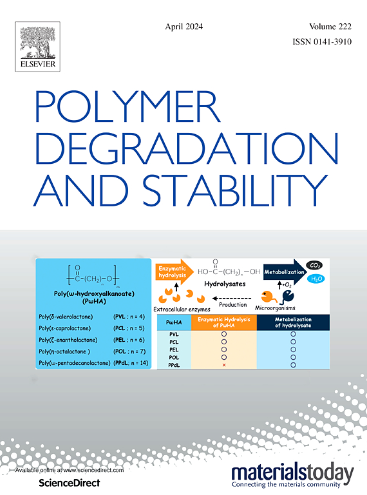Compatibility and degradation mechanisms of common aircraft sealing rubbers in C6F12O mixed systems: An integrated experimental and molecular dynamics study
IF 7.4
2区 化学
Q1 POLYMER SCIENCE
引用次数: 0
Abstract
Perfluoro-2-methyl-3-pentanone (C6F12O) is widely used in fire suppression systems due to its high extinguishing efficiency. However, during deployment, it can undergo hydrolysis in trace moisture, generating perfluoropropionic acid (PFPrA), which may degrade sealing materials and compromise system reliability. In this study, the compatibility and degradation behavior of C6F12O with three common aerospace elastomers - chloroprene rubber (CR), hydrogenated nitrile rubber (HNBR), and fluorosilicone rubber (FVMQ) - were systematically investigated under varying moisture contents (100–10,000 ppm) and temperatures (25 °C and 55 °C). Degradation behavior and interfacial interactions were analyzed through high-throughput aging in contact with chemicals experiments, physical and mechanical properties evaluations (including weight, hardness, tensile strength, elongation at break, and cross-link density), surface morphology analysis, elemental and functional group characterization, liquid-phase analysis, and molecular dynamics (MD) simulations. The results revealed that degradation severity increased with both moisture content and temperature, following the order CR > HNBR > FVMQ. All rubbers exhibited surface enrichment of C-F bonds. MD simulations show that PFPrA strongly adsorbs onto polar groups (C = C, C![]() Cl, C
Cl, C![]() N) in rubber via physical interactions, promoting interfacial accumulation and migration that may compromise stability. In contrast, its weak affinity for the inert Si-O backbone in FVMQ contributes to its superior resistance to degradation. The combined experimental and simulation results demonstrate that FVMQ exhibits the best chemical compatibility, making it the most suitable sealing material for aircraft fire suppression systems and ensuring long-term operational reliability.
N) in rubber via physical interactions, promoting interfacial accumulation and migration that may compromise stability. In contrast, its weak affinity for the inert Si-O backbone in FVMQ contributes to its superior resistance to degradation. The combined experimental and simulation results demonstrate that FVMQ exhibits the best chemical compatibility, making it the most suitable sealing material for aircraft fire suppression systems and ensuring long-term operational reliability.
通用飞机密封橡胶在c6f120混合体系中的相容性及降解机理:综合实验与分子动力学研究
全氟-2-甲基-3-戊酮(c6f120)因其灭火效率高而被广泛应用于灭火系统中。然而,在部署过程中,它会在微量水分中发生水解,产生全氟丙酸(PFPrA),这可能会降解密封材料,降低系统的可靠性。在本研究中,系统研究了c6f120在不同含水量(100-10,000 ppm)和温度(25°C和55°C)下与氯丁橡胶(CR)、氢化丁腈橡胶(HNBR)和氟硅橡胶(FVMQ)三种常见航空弹性体的相容性和降解行为。通过化学实验、物理和机械性能评估(包括重量、硬度、拉伸强度、断裂伸长率和交联密度)、表面形貌分析、元素和官能团表征、液相分析和分子动力学(MD)模拟,分析了降解行为和界面相互作用。结果表明,降解程度随含水率和温度的增加而增加,依次为CR >;天然橡胶的在FVMQ。所有橡胶表面都表现出碳氟键的富集。MD模拟表明,PFPrA通过物理相互作用强烈吸附在橡胶中的极性基团(C = C, CCl, CN)上,促进界面积累和迁移,可能会损害稳定性。相比之下,它对FVMQ中惰性Si-O主链的亲和力较弱,这使得它具有较好的抗降解能力。实验和仿真结果表明,FVMQ具有最佳的化学相容性,是飞机灭火系统最合适的密封材料,保证了长期的运行可靠性。
本文章由计算机程序翻译,如有差异,请以英文原文为准。
求助全文
约1分钟内获得全文
求助全文
来源期刊

Polymer Degradation and Stability
化学-高分子科学
CiteScore
10.10
自引率
10.20%
发文量
325
审稿时长
23 days
期刊介绍:
Polymer Degradation and Stability deals with the degradation reactions and their control which are a major preoccupation of practitioners of the many and diverse aspects of modern polymer technology.
Deteriorative reactions occur during processing, when polymers are subjected to heat, oxygen and mechanical stress, and during the useful life of the materials when oxygen and sunlight are the most important degradative agencies. In more specialised applications, degradation may be induced by high energy radiation, ozone, atmospheric pollutants, mechanical stress, biological action, hydrolysis and many other influences. The mechanisms of these reactions and stabilisation processes must be understood if the technology and application of polymers are to continue to advance. The reporting of investigations of this kind is therefore a major function of this journal.
However there are also new developments in polymer technology in which degradation processes find positive applications. For example, photodegradable plastics are now available, the recycling of polymeric products will become increasingly important, degradation and combustion studies are involved in the definition of the fire hazards which are associated with polymeric materials and the microelectronics industry is vitally dependent upon polymer degradation in the manufacture of its circuitry. Polymer properties may also be improved by processes like curing and grafting, the chemistry of which can be closely related to that which causes physical deterioration in other circumstances.
 求助内容:
求助内容: 应助结果提醒方式:
应助结果提醒方式:


